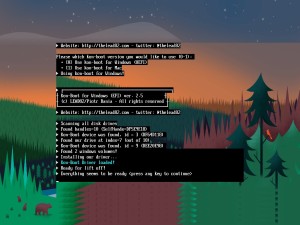Kon-Boot is an application which will silently bypass the authentication process of Windows based operating systems. Without overwriting your old password! In other words you can login to your Windows profile without knowing your password. Easy to use and excellent for tech repairs, data recovery and security audits. Fast, tiny and gets your job done!

I have received a user’s question about how to integrate Kon-Boot into the AIO Boot drive. This is quite simple, you just follow the instructions here. By default Kon-Boot is booted from Grub4Dos but we will replace it with Grub2.
Here’s how it applies to all versions of Kon-Boot, including KON-BOOT 2in1 for Windows and Mac OSX. It supports both UEFI and Legacy BIOS modes.
- Download Kon-Boot.
- Extract the downloaded file, you will see the kon-bootUSB directory. Continue to open this directory.
- In the kon-bootUSB directory there will be two folders, EFI and USBFILES.
- In the /EFI/Boot directory, rename bootx64.efi file to kon-bootx64.efi and rename bootia32.efi file to kon-bootia32.efi.
- Copy all the files contained in the /EFI/Boot directory to the /EFI/Boot directory of the AIO Boot drive.
- Copy all the files contained in the USBFILES directory to the root directory of the AIO Boot drive. Skip menu.lst and grldr.
- Open /AIO/Menu/Main.cfg file and add the following code:
### Start kon-boot menuentry "[r] Kon-Boot" --hotkey=r { if [ "$pc" ]; then linux16 ${memdisk} floppy initrd16 /konboot.img regexp -s disk 'hd(.*),' "$root" if [ "$disk" == "0" ]; then drivemap (hd1) (hd0); fi else chainloader /EFI/BOOT/kon-boot${_SPEC_UEFI_ARCH}.efi fi } ### End kon-boot
Good luck!

Confirmed working 4.13.20
Thank you for this valuable info and tool 🙂
not working with latest version 2.9 .
kon-boot not show in AIO boot menu!
For me KON-BOOT doesn’ t work on a multiboot USB drive, and it doees not matter if you use aioboot, YUMI or another multi boot loader, it always loads back into the multiboot loader and not into the Windows harddisk (or memory).
For me it only works if KON-BOOT is placed on the USB drive directly, without a second menu like in YUMI.